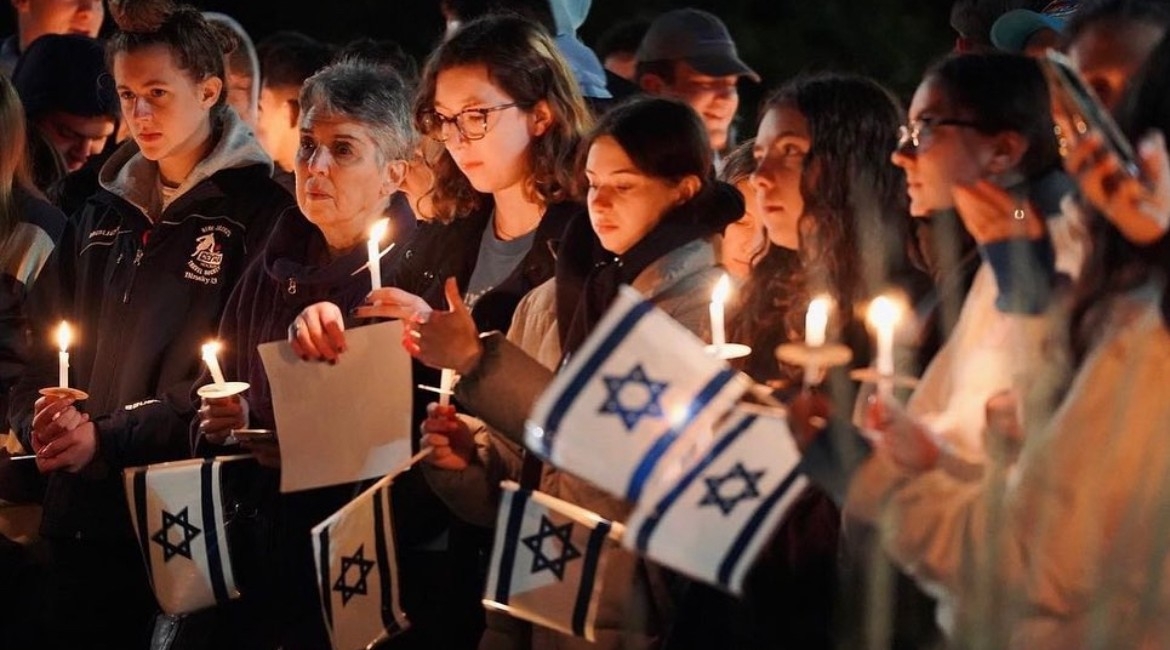(JTA) — Some Jewish students would like to see the Anti-Defamation League after class.
This week the antisemitism watchdog organization unveiled its Campus Antisemitism Report Card, a series of letter grades assigned to 85 colleges and universities based on how well the group believes they are addressing antisemitism. For many elite schools, the results were not good.
Only two schools — Brandeis, which was founded by Jews, and Elon — earned an “A.” Many others fared quite poorly, with Harvard, Stanford, Princeton and the Massachusetts Institute of Technology among the 13 “F” grades. Another 24 came away with “D”s, from Columbia and Barnard to Northwestern, Rutgers and Ohio State.
“Parents and students and other folks are used to seeing college grades and guides and rankings,” Shira Goodman, the ADL’s senior director of advocacy, told JTA. She compared the report cards to the influential national college rankings by U.S. News and World Report.
“It is recognizable, it’s easily understandable,” Goodman said. “And we needed a way to distinguish between schools that were getting it right, schools that were kind of on the right track but needed more work, and schools that we felt were failing. And a grade can do that.”
But according to some of the Jewish students and professionals working on the campuses, the ADL got it wrong. In the day or so since the ADL released the grades, a number of students and Hillel directors — along with the CEO of Hillel International — have spoken out about the letter grades. One called the grade a “massive oversimplification” of complicated yet vibrant realities for Jewish students.
Rabbi Gil Steinlauf, executive director of Princeton’s Center for Jewish Life, called the ADL’s “F” grade for the university “misleading.” “In truth, over the past two years of my deep engagement with Jewish life on Princeton’s campus, I can say very clearly that Princeton is a great place to be Jewish,” Steinlauf wrote in a statement. He added that Princeton’s leadership, administration and faculty are “deeply supportive of our Jewish students.”
The pushback from Hillel is especially notable, as Hillel and the ADL have publicly partnered on initiatives to assess, report and combat antisemitism on campus. The list of schools that the ADL graded was based on Hillel International’s list of the top 30 public and private campuses by Jewish enrollment, along with other top nationally-ranked colleges.
The criticism comes despite Jewish groups being largely in agreement that campus antisemitism has become a significant problem, particularly since the outbreak of the Israel-Hamas war on Oct. 7.
“We do not believe it is constructive or accurate to try to assign grades to schools as a means of assessing the totality of Jewish student experience at those campuses,” Adam Lehman, Hillel International’s president and CEO, told JTA in a statement. “Efforts to do so, however well-intended, produce misleading impressions regarding the actual Jewish student experience at those schools. On the contrary, we think it’s important for prospective students and families to pursue a more holistic understanding of Jewish campus life.”
Hillel and Chabad directors at several individual schools also decried the ratings system to JTA, including at Michigan State University (which scored an F), the University of Wisconsin-Madison, George Washington University and the University of Vermont (which all received Cs).
The Hillel and Chabad of Michigan State University issued a joint statement condemning the failing grade, saying it “misses the holistic picture of Jewish life on our campus.”
Greg Steinberger, director of Wisconsin’s Hillel, told JTA that Jewish life on his campus “is better than the grade offered by ADL, which has a limited view of the campus and the vibrant Jewish experience offered by the university, and by on-campus organizations like UW Hillel.”
Adena Kirstein, executive director of the Hillel at George Washington University, told the Jewish Telegraphic Agency in a statement, “We believe strongly that boiling down any campus climate or nuanced communal environment to a single letter grade is a massive oversimplification of very complex dynamics.”
GWU scored a “C” in the ADL’s assessment — which the organization characterizes as “Corrections Needed” — in part due to headline-grabbing incidents of pro-Palestinian students projecting phrases including “Glory to our martyrs” onto campus buildings. At the same time, the report card noted the school has an “active Jewish life” and an anti-BDS policy, has formed an advisory council to address antisemitism, is participating in a Hillel-led antisemitism education program, and “publicly condemns antisemitic incidents.”
Factors in other schools’ assessments also appeared to be in tension with each other. Dartmouth College, a school the Secretary of Education has celebrated for its approach to communal dialogue around Israel, was rated a C, with the ADL citing a small number of student protests and “calls for divestment.” Other schools were marked down for incidents that administrators have addressed. The University of Vermont, which received a “C”, recently pledged to devote significant resources toward protecting Jewish students as part of the results of a Department of Education investigation.
Vermont’s own Hillel director, who has criticized the school’s administration in the past, says that pledge from university leadership deserves more attention.
“Jewish students receive prompt responses and follow through when they file bias and harassment reports,” Matt Vogel told JTA in a statement. “Every campus in the country has antisemitism; what matters is how the university responds and the strong Jewish organizations that exist to support our communities.”
Responding to the criticisms Friday, ADL staff said they stood by the grading project and the process behind it. The ADL’s Goodman said the group views the grades as a “progress report” that can be changed if the schools take action. Several have already contacted the organization to ask how they can improve their standing, she said.
To determine how to assign the grades, ADL antisemitism researcher Masha Zemtsov said the group took a broad survey of Jewish college students nationwide, and also sent questionnaires to campus Hillel and Chabad representatives that could be filled out anonymously.
Individual students at each campus were not surveyed, though Goodman said the ADL hopes to do that in future years, along with expanding the roster of schools to grade.
The ADL also sent general queries to universities about their own steps to combat antisemitism, and sourced antisemitic incidents from a number of places: media reports; its own center on extremism, reports of incidents by students and faculty, and the Amcha Initiative, a pro-Israel campus advocacy group that compiles its own list of antisemitic incidents.
Campuses were graded, in part, on how well they responded to the ADL’s own requests to universities for how they can address antisemitism sent out at the start of the 2023-24 school year.
Some of the information included on its report cards, surrounding initiatives that are still in progress, was not actually taken into account while determining the schools’ grades; for example, whether a school was engaged in an active federal investigation or litigation, and whether it had pledged but not yet implemented an antisemitism strategy.
Zemtsov added that the ADL weighted three broad categories: incidents, Jewish student life and administrative policies around antisemitism. The weighting system, she said, was based on the responses in its survey of students, who she said gave more or less equal consideration to all three categories. This meant, said Zemtsov, that “there would be a student voice deciding how we basically weighted each of the criteria.”
The ADL also considered anti-Zionist protests, and gave particular weight to violent incidents and threats of violence, as well as incidents led by faculty or staff. Nonviolent student protests were given less weight.
ADL staff stressed to JTA that protests simply against Israeli policies wouldn’t count unless they crossed a line into more overt singling out of Israel. “We did not count just criticisms of the Israeli government, of the way Israel is prosecuting a war,” Zemtsov said, adding that the ADL only counted “really clear anti-Zionism, pro-terrorism, the way our center on extremism designates these things.”
Some Jewish groups said the ADL weighed Israel-related campus activity unfairly. Campuses with anti-Zionist protesters and active pro-Palestinian groups like Students for Justice in Palestine received markdowns in the “Incidents” portion of the ADL’s grading system.
Students active with J Street U, the campus arm of the liberal Israel lobby, said the ADL’s criteria didn’t match their experience.
“One of the criteria is, you’re doing well if you have pro-Israel programming on campus. Now, what that means to the ADL is radically different from what that means to someone who’s a part of J Street,” Meirav Solomon, a Jewish sophomore at Tufts University and president of the school’s J Street U chapter, told JTA.
The ADL gave Tufts an F; the school has recently had contentious student government-led BDS votes that resulted in Jewish students being targeted with antisemitic language. But Solomon said that doesn’t tell the whole story, and compared the ADL’s report cards to “outside groups” with ideological agendas that have fought for a piece of the campus antisemitism narrative since Oct. 7.
“To give us an F is to basically paint with a very wide brush over the actual, nuanced experiences of what it actually means to be a Jewish student on college campus right now,” she said. “It honestly feels dismissing of my Jewish college experience.”
JTA has documented Jewish history in real-time for over a century. Keep our journalism strong by joining us in supporting independent, award-winning reporting.






